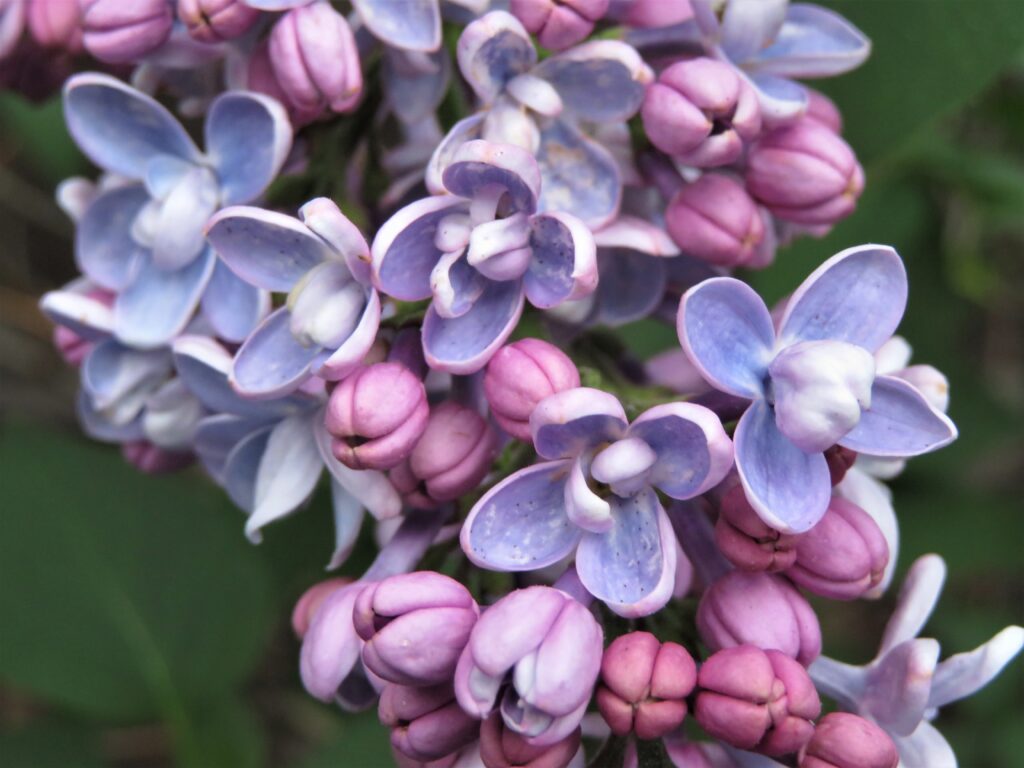
I think I’m late to the garden this year, although I’m not sure—I seem to have kept notes of everything last year except plantings. What I remember is that by the time I went to buy tomato starters last May, they were mostly gone. The person at one garden store shook her head sadly while telling me I was about two weeks too late. Because there was still frost at night, I thought I would have been too early. I guess time is only a construct when it comes to non-important daily activities, but necessary when it comes to nature. Or at least it matters more for tomato planting and less for flowers.
Last year I prepared a hasty garden bed adjacent to some overgrown lilacs in our side yard. I imagined it wouldn’t be too hard to pull up some of the leafy runners that were popping up just outside of the tumbling rock wall the previous owners had built, assuming rocks could somehow contain the lilacs. After a few hours of pulling and cutting runners, and several bags of soil, the tomatoes were in the ground and I was pleased with my efforts. Then, I read the details of the tomatoes: every variety would take 90+ days to produce fruit. That would bring us to…September by my finger calculations. Oh, well. I would do better next year, I promised myself.
However, I wasn’t satisfied with the tidiness of the lilacs around the tomato bed. Perhaps it was time I got down to the ground and started pulling up all of the runners throughout the yard and pruning the lilacs themselves. My grandmother grew lilacs in her back yard and what I remember is they seemed to be a uniform canopy of blooms every spring and shade throughout the summer. My grandmother was one of those magical gardeners who grew cucumbers, lilacs, roses and horseradish with equal success. I, on the other hand, mostly followed her around the yard complaining about the heat when I wasn’t reading Tiger Beat magazine in the shade of her linden tree.
My lilac shrubs looked nothing like my grandmother’s lilac trees, but I thought I could make them so if I worked harder at it. I sat in the dirt next to the bushes and started pulling up the green leafy shoots from the ground. I learned that these are called “suckers,” and I sure felt like one trying to figure out where a root began and ended. I only managed to pull and cut about six feet of lilac growth before giving up. My hands could no longer hold the pruning shears, and my back was sore. That night, I rubbed copious amounts of wintergreen-smelling analgesic lotion into my hands. Although I hate that particular flavor of gum and hard candy, in cream form it smells of impending relief.
I never returned to cutting back the lilacs in the rest of the yard and instead spent the summer feeding birds, watching skunks and rabbits, and trying my hand at growing succulents. I also watched a chipmunk eat the romaine lettuce I had planted. We had about five cherry tomatoes in August, which I considered a success. Next year, I promised myself, I’ll do better at this whole gardening thing.
However, my intentions won’t play out this year. Returning to the tomato bed last week, I noticed that the suckers I had dug out and cut back had returned with a vengence. I don’t mean just a few leaves popping up—the whole garden bed is overrun as though I’d never cut back anything at all. In fact, it looks as though I planted a whole new set of lilac bushes. Puzzled, I looked through The Farmers Almanac as well as some online plant sites. If only I had done some research ahead of time, I would have learned that the worst thing I could have done was cut the suckers back. That the more one cuts, the more the lilac tree fights to replace these root shoots as a kind of stress response. In trying to grow one kind of plant, I stressed the other plants out.
There’s a lesson in here about stress and resilience, I’m sure, but I don’t know that I’m ready for it yet. I’m not ready to grow back with a vengence, maskless, like some heroine in a summer blockbuster movie. It seems that the authors of every article and essay I’ve been reading the past two weeks implore me to return to restaurants and shopping, reminding me of the call to “support the economy” post-9/11. The constant pull toward a normalcy that was never comfortable is distressing.
Instead, I take my camera around the backyard and document the lilac blooms. I stick my nose in groups of flowers, sharing space in one cluster with a slow-moving pollen-drunk bee. The lilacs have lasted this whole week and are just now turning brown and dying. It seems impossible that the thin branches can support the weight of these grape-like clusters, but they do, even during a windy Flagstaff spring. I decided to turn the garden bed over to the lilac suckers. Let them bloom and take over the yard, spreading their sweet smell of victory next spring. The lesson I want to take from all of this right now is I’d rather be alone in my backyard, tomato-less, trying to hang onto a semblance of peace, trying to remember everything I’ve learned about myself this past year. I will let these feelings take root, multiply and replace anything that didn’t belong within me in the first place.

